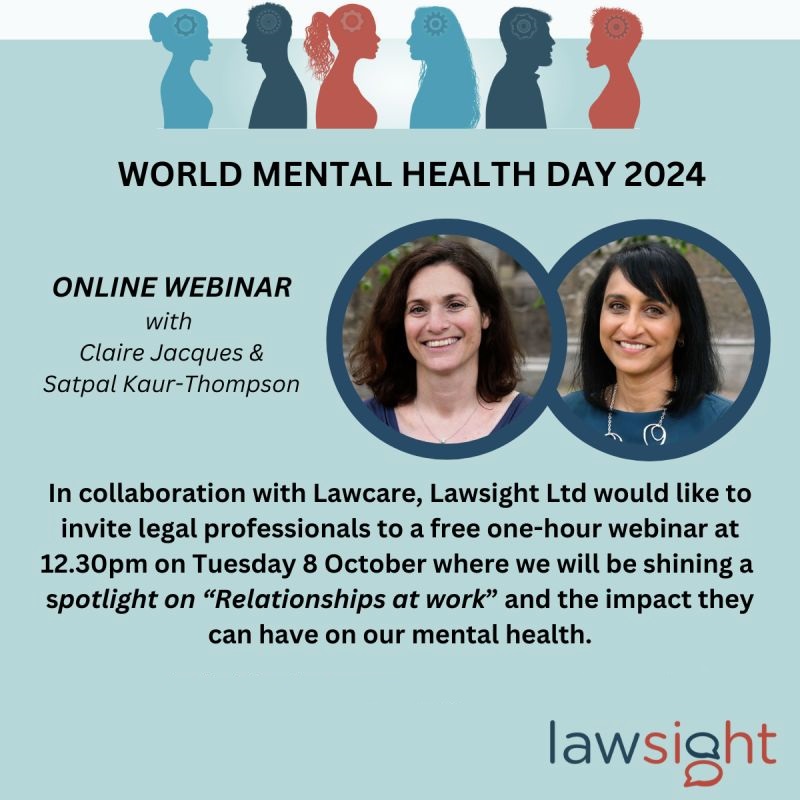World Mental Health Day 2024
Ever wondered about the impact that our relationships (whether personal or professional) have on our mental health? In this article, we explore the root causes of relationship challenges, how they can show up at work, and what we can do about them.
To help us navigate workplace relationships, especially the tricky ones, it’s worth exploring our earliest relationships, as they shape how we relate to ourselves, others, and the wider world. Our histories and ‘relationship style’ provide clues about what might be going on beneath the surface when we interact with others.
Attachment theory and internal working models
Psychiatrist John Bowlby pioneered the popular ‘attachment theory’ – proposing that humans are born with an innate need to seek connection and proximity (for survival). These attachment bonds are necessary for the development of the brain and nervous system, as well as for emotional regulation, particularly during times of stress.
Over time, we internalise our original relationship experiences (for example, whether we were able to trust others to be there for us during times of stress) which create templates for all relationships that we carry into adulthood – known as our ‘internal working models’. These models act as an inner guide that influences our emotions, behaviour, interactions and expectations of others in relationships, all of which tend to be outside of our awareness.
Internal working models and our view of ourselves
As our internal working model of ourselves also forms during our earliest relationship experiences, we learn how acceptable we are (that is. whether we feel worthy or rejected) based on the responsiveness of those around us.
Hopefully we received ‘good enough’ care, and we grew to have a positive self-image. However, if we received neglectful or inconsistent care, we are likely to develop a negative self-image and have low self-esteem.
Attachment styles
Researchers have identified four attachment styles in adults (secure attachment and the other three – anxious, avoidant and disorganised – are considered insecure) based on the internal working models of ourselves and others.
- Secure – People with this attachment style are confident, trusting, have a positive self-worth and can regulate their emotions well. They are comfortable being alone and forming close relationships with others.
- Anxious – People with this attachment style may fear rejection and feel unworthy. They tend to worry about relationships, doubt themselves and have low self-esteem.
- Avoidant – People with this attachment style enjoy their independence, can be mistrusting of others and feel unworthy. They protect themselves from anticipated rejection by avoiding close involvement with others.
- Disorganised – People with this attachment style may have trouble identifying and regulating their emotions. They may also avoid strong emotional attachments and move between anxious and avoidant traits.
It is worth noting that each attachment style exists on a spectrum and although we tend to have one predominant style, it may also vary depending on the context.
How are our internal working models and attachment styles relevant to our working lives?
Our attachment styles can affect the way we function and perform at work. The workplace can become a breeding ground for recreating our internal working models and where our insecure attachment styles play out. People with insecure attachment styles may be people pleasing and seek approval from others, or be distant and self-reliant, finding it difficult to collaborate. Work-related disappointments, such as not securing a promotion, may cause disproportionate levels of distress if earlier feelings of unworthiness or rejection are reactivated.
Reflect for a moment and consider your comfort zone at work – might you perceive a situation to be threatening when rationally it is not? Do you keep a distance from peers and colleagues, preferring to work alone or do you prefer to work closely with others? Do you seek validation?
Often, the difficulties we encounter at work, not only stem from the actual pressures we face – such as performance reviews, income targets, client demands and time recording – but also from our minds (and nervous systems) instinctively but unknowingly replaying and reactivating the attachment style former when we were younger.
The hierarchical nature of organisational structures can amplify our insecurities, making us sensitive to authority figures during times of stress and pressure and criticism can feel personal. Sometimes we create an internal critic to pre-empt any external criticism. This is often the way our brains protect us, by becoming both an ally and a defence.
Similarly, if our self-worth is dependent on professional success and achievements then we may work hard to try to impress others, seeking validation and being ‘perfect’ to feel good enough on the inside. Working in law can often exacerbate these behaviours due to the demanding nature of the profession and the frequent evaluation and judgement that comes with it.
The A, B, C of managing relationships at work
Awareness – When we become aware of our attachment patterns and internal working models, we can get curious about whether what is going on relates to the here and now or whether it may be influenced by earlier experiences. This can allow us to function from a place of consciousness and choice, rather than unawareness.
Bravery – It is not always easy to identify our attachment patterns and internal working models by ourselves. This is when we need to be brave and ask for feedback from trusted people or seek professional help from a coach or therapist to help uncover our blind spots.
Compassion – Replace criticism with compassion. Self-compassion is a key step towards lessening the influence of your inner critic and improving your mental and emotional health. It is a skill that can be practiced through self-kindness (treating yourself like you would treat a friend) and mindfulness (observing and labelling your thoughts and emotions rather than reacting to them).
This article was written by Satpal Kaur-Thompson of Lawsight, who provide counselling and training to legal professionals and their organisations. For further information visit www.lawsight.co.uk or email enquiries@lawsight.co.uk

 Satpal Kaur-Thompson
Satpal Kaur-Thompson